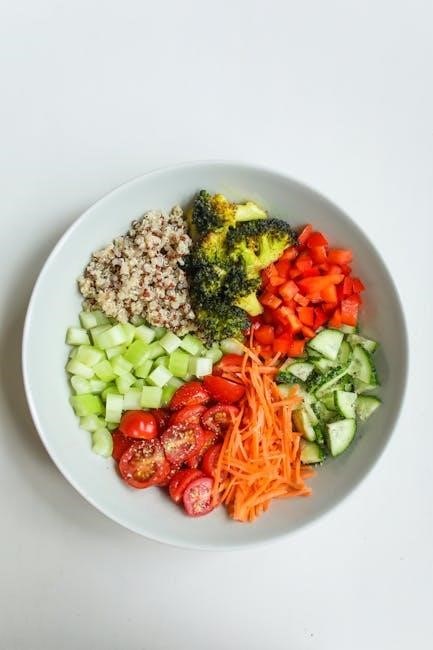Understanding the Bland Diet
The bland diet is designed to rest the digestive system‚ promoting healing and reducing irritation. It includes soft‚ low-fiber foods that are easy to digest‚ often recommended for conditions like ulcers‚ GERD‚ or inflammation. Consult a healthcare provider for personalized guidance.
What is the Bland Diet?

The bland diet‚ also known as the low-residue or soft diet‚ is a dietary plan designed to minimize digestive stress and irritation. It focuses on foods that are easy to digest and less likely to cause inflammation or discomfort in the digestive system. This diet is often recommended for individuals recovering from gastrointestinal surgery‚ experiencing digestive disorders‚ or managing conditions like ulcers‚ acid reflux‚ or inflammatory bowel disease.
The bland diet emphasizes soft‚ low-fiber foods that are gentle on the stomach and intestines. It avoids spicy‚ fatty‚ or high-fiber foods that can irritate the digestive tract. The goal is to provide adequate nutrition while allowing the gut to heal and reduce symptoms like nausea‚ heartburn‚ or diarrhea. This diet is typically temporary and is adjusted based on individual tolerance and medical needs.
Key components of the bland diet include foods such as bananas‚ rice‚ applesauce‚ and toast (often referred to as the BRAT diet)‚ as well as lean proteins‚ low-fat dairy‚ and cooked vegetables. The diet is tailored to reduce digestive workload and promote recovery‚ making it a common recommendation for those with sensitive digestive systems or during post-operative care.

Purpose of the Bland Diet
The primary purpose of the bland diet is to provide relief and support for individuals with digestive discomfort or conditions affecting the gastrointestinal tract. It is designed to minimize irritation and allow the digestive system to heal by avoiding foods that are hard to digest‚ spicy‚ or high in fiber. This diet is often recommended for managing symptoms of conditions such as ulcers‚ acid reflux‚ GERD‚ nausea‚ and inflammatory bowel disease.
By focusing on soft‚ easily digestible foods‚ the bland diet reduces the workload on the stomach and intestines‚ giving them time to recover. It is also commonly used during recovery from gastrointestinal surgery or for individuals experiencing post-operative sensitivity. The diet helps prevent discomfort‚ such as heartburn‚ bloating‚ or diarrhea‚ while ensuring the body still receives essential nutrients. Over time‚ the bland diet can help restore normal digestive function and improve overall well-being.
Key Components of the Bland Diet
The bland diet focuses on selecting foods that are gentle on the digestive system‚ minimizing discomfort and irritation. It emphasizes soft‚ low-fiber foods that are easy to chew and digest‚ avoiding spicy‚ fatty‚ or high-fiber options that can aggravate conditions like ulcers or GERD. The diet prioritizes lean proteins‚ such as poultry or fish‚ and low-acid fruits and vegetables to reduce stomach acid production.
Key components also include avoiding irritants like caffeine‚ alcohol‚ and carbonated beverages‚ which can exacerbate digestive issues. Foods high in sugar or salt are also limited to prevent inflammation. The diet encourages small‚ frequent meals to ease digestion and prevent overloading the stomach. Additionally‚ it recommends avoiding raw or undercooked foods‚ as well as those with seeds or skins‚ which can be difficult to digest.
Hydration is another critical aspect‚ with water‚ herbal teas‚ and clear broths being encouraged to support digestive health. The bland diet is tailored to individual needs‚ so consulting a healthcare provider or dietitian is essential to ensure it meets specific health requirements and promotes healing. This structured approach helps restore normal digestive function while maintaining nutritional balance.
Foods to Include in the Bland Diet

The bland diet emphasizes foods that are gentle on the digestive system‚ reducing irritation and discomfort. Ideal choices include soft‚ low-fiber foods such as bananas‚ plain rice‚ applesauce‚ and crackers. Lean proteins like cooked chicken‚ turkey‚ or fish (without skin or bones) are also recommended‚ as they are easy to digest and provide essential nutrients.
Low-fat dairy products‚ such as yogurt or milk‚ are included to support calcium intake and soothe the stomach. Whole grains like oatmeal or refined bread can be added in small portions‚ as they are less likely to cause inflammation. Cooked vegetables‚ such as carrots‚ green beans‚ or potatoes‚ are acceptable when prepared without seeds or skins. Fruits like ripe melons or cooked apples are also suitable options.
Clear broths‚ herbal teas‚ and water are encouraged to stay hydrated without irritating the digestive tract. Foods should be prepared without added spices‚ oils‚ or fats to maintain their gentle nature. By focusing on these foods‚ the bland diet helps reduce discomfort and supports healing while ensuring adequate nutrition.
Foods to Avoid in the Bland Diet
When following a bland diet‚ it is crucial to avoid foods that can irritate the digestive system or exacerbate conditions like ulcers‚ GERD‚ or inflammation. Foods high in spice‚ fat‚ or fiber should be excluded‚ as they can trigger discomfort or impede healing.

Spicy foods‚ such as hot peppers or heavily seasoned dishes‚ are off-limits due to their potential to irritate the stomach lining. Fatty or fried foods‚ including red meat‚ processed meats‚ and oils‚ are also avoided because they can slow digestion and worsen symptoms. High-fiber foods like whole grains‚ nuts‚ seeds‚ and raw vegetables should be avoided initially‚ as they can be difficult to digest and cause inflammation.
Caffeinated beverages‚ alcohol‚ and carbonated drinks should also be eliminated‚ as they can stimulate acid production or cause bloating. Additionally‚ citrus fruits and tomatoes‚ which are highly acidic‚ should be avoided to prevent further irritation. By steering clear of these foods‚ individuals can better manage their symptoms and support their digestive health. Avoiding these triggers is essential for the effectiveness of the bland diet.
Portion Control and Meal Frequency
Portion control and meal frequency play a significant role in the success of the bland diet. Eating smaller‚ more frequent meals throughout the day can help ease digestion and prevent overwhelming the digestive system. Aim for 4-6 small meals instead of 2-3 large ones to maintain steady nutrient intake without causing discomfort.
Portion sizes should be moderate‚ avoiding overloading the stomach. Foods should be eaten slowly and chewed thoroughly to ensure they are well-digested before swallowing. This approach reduces the risk of indigestion and allows the digestive system to heal effectively. Additionally‚ spacing meals evenly can help maintain energy levels and prevent hunger pangs.
It is important to listen to your body and adjust portion sizes based on how you feel. If certain foods cause discomfort‚ even in small amounts‚ they should be avoided or reintroduced gradually. Consulting with a healthcare provider or dietitian can help tailor meal portions and frequency to individual needs‚ ensuring the diet is both effective and sustainable.
How to Transition to the Bland Diet

Transitioning to the bland diet requires a gradual approach to minimize digestive discomfort and ensure a smooth adjustment. Start by incorporating bland foods into your meals while reducing the intake of spicy‚ fatty‚ or high-fiber foods. For example‚ replace crunchy vegetables with cooked‚ mashed options‚ and opt for lean proteins over fried or processed meats. It’s important to plan meals in advance to avoid relying on last-minute‚ less healthy choices. Keeping a food diary can help track what works well and what may cause issues‚ allowing for adjustments as needed. Staying hydrated is also crucial‚ as water aids digestion and prevents constipation. Avoid introducing multiple new foods at once‚ as this can make it difficult to identify triggers of discomfort. Instead‚ add one food at a time and monitor your body’s response. Consulting with a dietitian or healthcare provider can provide personalized guidance and ensure a successful transition. Remember‚ consistency is key‚ and patience during this process will help your body adapt effectively.
Reintroducing Foods After the Bland Diet

After following the bland diet‚ reintroducing foods should be done gradually and with caution to avoid digestive discomfort. Start by adding one food at a time‚ beginning with small portions‚ and monitor how your body reacts. Choose foods that are mild and low in spice‚ such as steamed vegetables or whole grains‚ and avoid high-fiber or fatty options initially. Keep a food diary to track which foods are well-tolerated and which may cause issues. If symptoms like bloating‚ nausea‚ or heartburn reoccur‚ it may be necessary to delay further introductions or consult a healthcare provider. It’s important to prioritize nutrient-rich foods while gradually expanding your diet. Patience is key‚ as the goal is to rebuild tolerance without overwhelming the digestive system. A slow and methodical approach ensures a smooth transition and minimizes the risk of setbacks‚ helping you maintain long-term digestive health.
The bland diet is a valuable approach for individuals needing to rest their digestive system and promote healing. By focusing on soft‚ low-fiber foods‚ it reduces irritation and minimizes discomfort‚ making it ideal for conditions like ulcers‚ GERD‚ and inflammation. This diet ensures that essential nutrients are absorbed without putting excessive strain on the digestive tract. Its structured nature helps patients avoid triggers that could worsen their symptoms‚ providing a clear pathway to recovery. While it is typically recommended for short-term use‚ the bland diet plays a crucial role in managing digestive health during critical periods. Always tailored to individual needs and often guided by healthcare providers‚ the bland diet is a practical and effective solution for those requiring a gentle‚ restorative eating plan.



